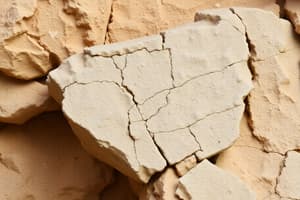Podcast
Questions and Answers
cementování
cementování
- Zvýšení síly a trvanlivosti (correct)
- Snížení síly a trvanlivosti
- Negativní vliv na složení nerostů
- Zvýšení porozity a permeability
Jak může znalost cementace ovlivnit ekonomické rozhodování?
Jak může znalost cementace ovlivnit ekonomické rozhodování?
- Nastavením limitů těžby nerostů
- Pomocí zvýšení porozity sedimentů
- Ovlivněním povrchových vod
- Odhadováním toků fluid za účelem rezervace ropy (correct)
Jaký je význam studia typu a množství cementu pro geology?
Jaký je význam studia typu a množství cementu pro geology?
- Odráží geologickou historii oblasti (correct)
- Znamená to zjištění teploty uvnitř hornin
- Pomáhá v predikci pohybu zemních vln
- Nastavuje normy pro stavební projekty
Jaký vliv má cementace na pohyb podzemních vod?
Jaký vliv má cementace na pohyb podzemních vod?
Jak cementace ovlivňuje zásoby uhlovodíků v geologických strukturách?
Jak cementace ovlivňuje zásoby uhlovodíků v geologických strukturách?
Jaký je hlavní způsob, jakým se sedimenty během cementace spojují?
Jaký je hlavní způsob, jakým se sedimenty během cementace spojují?
Který z následujících faktorů NEOVLIVŇUJE proces cementace?
Který z následujících faktorů NEOVLIVŇUJE proces cementace?
Jaký typ cementu je obvyklý v pískovcích?
Jaký typ cementu je obvyklý v pískovcích?
Který z následujících procesů NENÍ součástí cementace?
Který z následujících procesů NENÍ součástí cementace?
Jaký typ cementace je považován za nejběžnější?
Jaký typ cementace je považován za nejběžnější?
Jakým způsobem ovlivňuje porozita cementaci sedimentů?
Jakým způsobem ovlivňuje porozita cementaci sedimentů?
Jaké oxidy často slouží jako cementující činidla v prostředích s oxidací?
Jaké oxidy často slouží jako cementující činidla v prostředích s oxidací?
Jaký vliv mají teplota a tlak na cementaci?
Jaký vliv mají teplota a tlak na cementaci?
Flashcards
Zpevnění sedimentů
Zpevnění sedimentů
Proces, při kterém se minerály rozpuštěné v tekutinách usazují v pórech sedimentu a zpevňují ho.
Vliv na pevnost a odolnost
Vliv na pevnost a odolnost
Zpevnění významně zvyšuje pevnost a odolnost hornin.
Změtna a propustnost
Změtna a propustnost
Zpevnění snižuje pórovitost a propustnost, což omezuje proudění tekutin.
Geologická historie
Geologická historie
Signup and view all the flashcards
Použití v inženýrství
Použití v inženýrství
Signup and view all the flashcards
Cementation
Cementation
Signup and view all the flashcards
Cementující látka
Cementující látka
Signup and view all the flashcards
Poréznost
Poréznost
Signup and view all the flashcards
Propustnost
Propustnost
Signup and view all the flashcards
Chemické složení tekutin
Chemické složení tekutin
Signup and view all the flashcards
Precipitace
Precipitace
Signup and view all the flashcards
Krystalizace
Krystalizace
Signup and view all the flashcards
Mechanické cementem
Mechanické cementem
Signup and view all the flashcards
Study Notes
Cementation
- Cementation is a process where loose sediment grains are bound together by a mineral-rich cement.
- This process strengthens the sediment, transforming it into a cohesive rock.
- The cementing agent is usually a mineral precipitate that fills the pores and spaces between the sediment grains.
- Common cementing agents include silica, calcite, and iron oxides.
- The type of cement depends on the chemical environment during the formation of the rock.
- Silica cement is common in sandstones, forming from solutions containing dissolved silica.
- Calcite cement is often found in limestones and some sandstones, precipitating from groundwater containing dissolved calcium carbonate.
- Iron oxides, such as hematite and goethite, are common cementing agents in rocks formed in oxidizing environments.
Factors Affecting Cementation
- Porosity: The interconnectedness of pores within the sediment. Lower porosity allows for better cementation as there is less space to be filled.
- Permeability: The ability of fluids to move through the sediment. Higher permeability allows for more efficient transport of cementing agents.
- Fluid Composition: The chemical composition of the fluids percolating through the sediment. Different ions in the solution dictate what minerals precipitate.
- Temperature and Pressure: These variables influence the solubility of minerals and the rate of reactions involved in cementation.
- Time: Cementation is a gradual process, often taking long periods of geological time.
Processes Involved in Cementation
- Precipitate Formation: The cementing agents must be transported and deposited in the spaces between the sediment grains.
- Crystal Growth: The cementing minerals crystallize from solution, adhering to the surrounding grains.
- Binding: The cement forms a strong bond between the sediment particles.
- Compaction: During the process of cementation, the rock undergoes compaction due to added weight and the force of the surrounding materials. This can further reduce porosity and space for further cementation.
- Dissolution: While cementation is a precipitation process, some minerals may dissolve during some stages or over geologic time.
Types of Cementation
- Mechanical Cementation: Physical bonding of grains by clastic particles of different size like clay or silt-sized particles. This is less common.
- Chemical Cementation: The most common method. Dissolved minerals precipitate from fluids saturating the sediment pores.
Importance of Cementation
- Strength and Durability: Cementation significantly increases the strength and durability of sedimentary rocks.
- Porosity and Permeability Changes: It leads to a decrease in porosity and permeability, reducing the flow of fluids through the rock.
- Economic Implications: Knowledge of cementation is useful in scenarios such as petroleum reservoir evaluation due to their effect on pore space and fluid flow.
- Geological Interpretation: By studying the type and amount of cement, geologists can learn about the geological history of the area.
Applications of Cementation
- Engineering: Understanding the properties of cemented rocks is crucial for activities such as dam construction and excavation.
- Hydrogeology: It influences groundwater flow paths and aquifer properties.
- Petroleum Geology: Cementation is a key factor in petroleum reservoir formation due to its impact on porosity and permeability, which affects hydrocarbon storage.
Studying That Suits You
Use AI to generate personalized quizzes and flashcards to suit your learning preferences.




